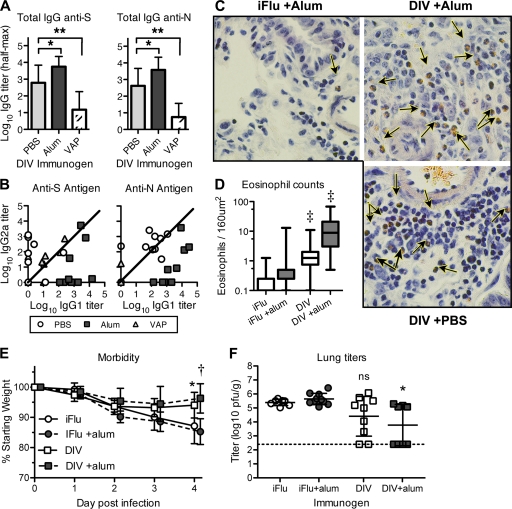Fig. 1.
DIV vaccination and nonlethal heterologous challenge in aged animals. (A) Log10 half-maximum ELISA titers for anti-N and anti-S total IgG antibodies following DIV immunization. One-year-old aged NIA mice were immunized with DIV (n = 10), DIV plus alum (n = 9), or DIV plus VAP (n = 9). The values were statistically compared by a Mann-Whitney test. The error bars indicate standard deviations. (B) Log10 half-maximum ELISA titers of IgG1 versus IgG2a subtypes. Each point represents log10 IgG1 and IgG2a half-max titers for a single mouse. (C) Representative images (×400 magnification) of eosinophil infiltration in icGD03-S-challenged mice following DIV or iFlu vaccination regimens. Lungs taken 4 days postinfection were sectioned and stained with Congo red, a reliable and specific stain for eosinophils (arrows). (D) Box and whisker counts of eosinophils proximal to airways in icGD03-S-challenged aged mice, with the range shown by the whiskers. Eosinophils were counted in 4 160-μm2 regions proximal to airways (5 airways per mouse). The counts were statistically compared to those of adjuvanted controls by a t test with Welch's correction. (E) Mice challenged with the icGD03-S virus were weighed daily and visually assessed for morbidity. DIV and DIV-plus-alum immunogens significantly reduced the morbidity associated with icGD03-S challenge by day 4 postchallenge. (F) Mice were harvested on day 4, and one-quarter of the lung was homogenized, with the titer determined by plaque assay. Lung titers were sporadically reduced for both the DIV and DIV-plus-alum groups, with only DIV plus alum reaching statistical significance by the Mann-Whitney test. *, P < 0.05; **, P <0.01; †, P <0.001; ‡, P <0.0001.

